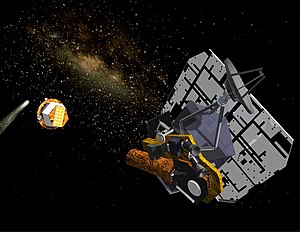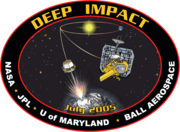Deep Impact (spacecraft)

Artist's impression of the Deep Impact space probe after deployment of the impactor.
|
|||||
| Mission type | Flyby · impactor (9P/Tempel) | ||||
|---|---|---|---|---|---|
| Operator | NASA · JPL | ||||
| COSPAR ID | 2005-001A | ||||
| SATCAT № | 28517 | ||||
| Website | www |
||||
| Mission duration | Final: 8 years, 6 months, 26 days | ||||
| Spacecraft properties | |||||
| Manufacturer | Ball Aerospace · University of Maryland | ||||
| Launch mass | Spacecraft: 650 kg (1,430 lb) Impactor: 370 kg (820 lb) |
||||
| Power | 620 W (solar array / NiH 2 battery) |
||||
| Start of mission | |||||
| Launch date | January 12, 2005, 18:47:08 UTC | ||||
| Rocket | Delta II 7925 | ||||
| Launch site | Cape Canaveral SLC-17B | ||||
| Contractor | Boeing | ||||
| End of mission | |||||
| Disposal | Contact lost | ||||
| Last contact | August 8, 2013 | ||||
| Flyby of Tempel 1 | |||||
| Closest approach | July 4, 2005, 06:05 UTC | ||||
| Distance | ~500 km (310 mi) | ||||
| Tempel 1 impactor | |||||
| Impact date | July 4, 2005, 05:52 UTC | ||||
|
|
|||||

Official insignia of the Deep Impact mission
Deep Impact was a NASA space probe launched from Cape Canaveral Air Force Station at 18:47 UTC on January 12, 2005. It was designed to study the interior composition of the comet Tempel 1 (9P/Tempel), by releasing an impactor into the comet. At 05:52 UTC on July 4, 2005, the impactor successfully collided with the comet's nucleus. The impact excavated debris from the interior of the nucleus, forming an impact crater. Photographs taken by the spacecraft showed the comet to be more dusty and less icy than had been expected. The impact generated an unexpectedly large and bright dust cloud, obscuring the view of the impact crater.
Previous space missions to comets, such as Giotto and Stardust, were fly-by missions. These missions were able to photograph and examine only the surfaces of cometary nuclei, and even then from considerable distances. The Deep Impact mission was the first to eject material from a comet's surface, and the mission garnered large publicity from the media, international scientists, and amateur astronomers.
Upon the completion of its primary mission, proposals were made to further utilize the spacecraft. Consequently, Deep Impact flew by Earth on December 31, 2007 on its way to an extended mission, designated EPOXI, with a dual purpose to study extrasolar planets and comet Hartley 2 (103P/Hartley).
...
Wikipedia
